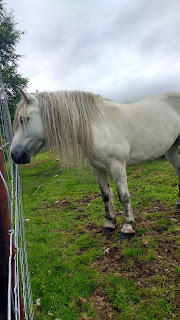Go back to basics!! The best advice I was ever given
My horse wont load.
My horse wont lead.
My horse is a nightmare.
My horse bites.
My horse kicks.
Issues... issues and more issues.
And I have been there, I was one of the people that used to complain constantly about what a pain in the backside my horse could be.
One day I got some advice.
Go back to basics, if he's not what you want, start again and go back to basics. Teach him to be what you want. Show him the way. Start again.
So your horse won't load.
So stop asking him to load.
Why won't he load?
Scared of the small space?
Had a bad experience?
Doesn't like the noise when he sets foot on the ramp?
Claustrophobic?
Or is he just lacking in respect?
Well, take the trailer out of the equation.
Go back, way back. Imagine that your horse or pony has only just started to be handled. Think about the lessons that they have learned.
Have they learned to yield to pressure?
Are they sensitive to your aids, on the ground and in hand?
I can safely say that even a short lesson in the correct way to respond to pressure can reap the benefits when you need to load a horse. Obviously, all horses are different. The experience I am going to tell you about involves young horses that were not halter broken, they didn't lead but they were incredibly confident.
They live the first part of their life, up until about three years old (or until the Colts are ready to geld) running as a group in a large field.
They love it and they get a lot of fuss and attention.
As a result, although they are uneducated they tend to be very friendly, loving fuss and attention.
So, a couple of years ago we were faced with an issue.
One of the Colts, 2 years old at the time, had gotten himself in a bit of a pickle.
Long story short, he didn't lead, and the only way to get him back up to the farm was to load him up and drive him back.
So I headed down to him, knotted halter in hand and got to work.
We literally worked for 20 mins. I just applied pressure and the second that he yielded I released that pressure. When the lorry arrived we had established the basics of turning and taking a few steps with me when I went to lead him.
This colt was by no means halter broke, but I would have to hope that it was enough.
The ramp was dropped and he eyed it a little warily.
I didn't mind how long it took, I just knew that at some point he had to load, we had to get him back to the farm.
So we did a lot of advance and retreat.
When he stepped up onto the ramp I asked him to step back off it.
When he stepped back I walked a little further up the ramp.
Now despite the urge to carry on into the lorry I knew that I wanted him to feel comfortable, so even when his front feet were in I asked him to back out again. we then walked right into the lorry three for four times and also unloaded.
The method behind this was that he gained confidence with his feet, he learned that it was ok to walk in and out.
He made mistakes, he pulled me around and he worked it out.
It took about an hour.
But he did it.
We loaded him, and he got home, and then he got the treatment and attention that he needed.
Did I halter break him in that session?
No.
Did I set out halter break him?
No.
I set out to give him the best experience possible out of a situation that was less than ideal.
I succeeded.
I set out to make his first experience a successful one for both myself and him.
I succeeded.
He's now gelded and back out with his gang.
He will wear a head collar and lead in a fashion but he needs work. Hopefully I will halter break him properly this winter.
My point with this was to show how important that groundwork is.
Without some very brief basic lessons, we might not have been able to get him in.
We might not have been able to help him.
But it all comes down to that first lesson.
He has tonnes to learn, but if I get the chance to be the one that gives him those first lessons when he comes in then I will ensure that it's done thoroughly in the best way possible.
We went back to the start and we avoided what could have been a huge problem.
So use the same method with your own horses to fix problems.
Go back to the start.
Imagine that like the colt, they had no clue.
That they were that way because they had not been taught to behave properly.
You might be surprised at the results you get.
What I did with that colt is not a method, dont think that. It was just an example of what can be acheived when the horses is shown, and can understand what is asked of him.
And a horse and only give you the right answers if he has the right foundations.
If his foundations are wrong and we keep building, we get something unstable... and then we get issues.
So take him or her back, and fix the foundations.
Equip them for success!



Comments
Post a Comment